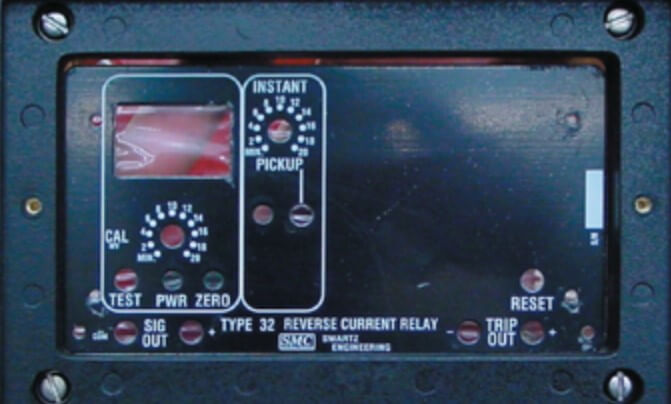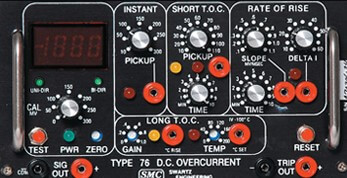Overcurrent Monitoring Relay
The term "current monitoring relay" is used to describe a relay that protects against excessive current caused by an electrical fault or any other condition.
The fault can either be high or low current. While many current monitor relays are able to detect both types of current, others will only sense one.
The overcurrent relay is placed in the circuit it will protect. The relay will open the circuit if the current in the circuit exceeds the set threshold. This helps prevent damage to equipment and injuries to people.
Types of Overcurrent Relays
On the market today, there are several types of overcurrent relays. They differ mainly in terms of their features, functionality, design, and intended use. Overcurrent relays are classified as follows:
1. Instantaneous Overcurrent Relay
Instantaneous Overcurrent Relay is the first type of relay. This relay type is designed to protect against very high currents for a short time (less than 0.1 seconds). This type of current can be caused by faults within the system, such as a circuit short.
This relay has a low delay time, which means it will trip the circuit or open it as soon as current is detected. It is crucial to remove the source of overcurrent quickly to avoid damage to your electrical system.
These types of overcurrent relays are used in transformers, outgoing feeders, and busbars. The instantaneous relay can protect against faults in these applications that would otherwise cause extensive damage.
2. Inverse Time Overcurrent Relay
Inverse time overcurrent is the second type of relay. The operating time of the inverse-time overcurrent relay is inversely proportional, unlike the instantaneous type.
This means that a higher current will decrease the time required for the relay's operation, whereas a lower current will increase the time needed, up to 10 seconds. This is important to prevent false trips if there is only a brief surge of current.
These types of overcurrent relays are mainly used in distribution systems. Based on their time delay characteristics, inverse time overcurrent relays can be further classified as an inverse definite-time relay, a very inverse, or an extreme inverse.
-Normal Inverse Time Overcurrent Relay: These relays offer a smaller or larger change in operating time when the magnitude of the current changes. They are often used in industrial settings and utility systems.
- Very Inverse Time Overcurrent Relay: The operating time of a very inverse-time overcurrent relay is more affected by the magnitude of the current than a normal inverse-time overcurrent relay. These relays are well-suited to applications with smaller fault currents.
- Relay with Extremely Inverse Time: The operating time of an extremely inverse-time overcurrent relay is the most affected by the change in current magnitude compared to all other inverse-time overcurrent relays. These relays react quickly to fault situations and are used to protect cables, motors, transformers, heaters, and pumps from overheating.
- Long-Time Inverse Overcurrent Relay: This type of relay has an extremely long operating time, up to 60 seconds. It is less sensitive than other types of overcurrent relays and is used in installations with a lower risk of faults to protect against Earth Faults.

GET IN TOUCH
The ultimate solution for reliable power control! call us at 276-285-3841
3. Definite Time Delay Overcurrent Relay
- Overcurrent Relay with a Definite Delay Time:** This relay type is similar to an inverse time-delay overcurrent relay in that it will only trip or open the circuit if the current exceeds a specific level for a specified amount of time. The definite time-delay overcurrent relay, however, has a set or fixed time delay.
The relay will always trip or open the circuit in the same amount of time, no matter how much current is flowing. This is usually set by the user. These types of overcurrent relays operate regardless of the current amount as long as it is above a predetermined value. They can be used for applications like transmission lines or transformers, where the trip must occur after a certain time delay.
4. Direct Current Relay
Overcurrent relays with directional capabilities are used in systems where current can flow in either direction. They can be used to detect faults within a ring main.
Directional overcurrent relays can only be used when current flows in the desired direction, preventing unnecessary trips or circuit-breaker operations when there are multiple current paths or power sources.
The directional overcurrent relay protects circuits in applications such as:
- Ring Main Unit (RMU)
- Radial Distribution System
- Generator Protection
Use the directional overcurrent relay in conjunction with other relays for complete system protection.

GET IN TOUCH
The ultimate solution for reliable power control! call us at 276-285-3841
Conclusion
In the realm of electrical engineering and power system protection, overcurrent monitoring relays stand as steadfast guardians, tirelessly watching over our intricate electrical networks. As we reach the conclusion of this exploration into the world of overcurrent relays, it becomes abundantly clear that their significance cannot be overstated.
These unassuming devices play a pivotal role in safeguarding equipment, infrastructure, and, most importantly, lives. Their ability to detect and respond to excessive currents, whether caused by faults or other unforeseen circumstances, is the linchpin of electrical safety.
The diversity of overcurrent relay types discussed in this article underscores the adaptability of these devices. From instantaneous relays, swift as lightning in their response to catastrophic faults, to inverse time relays, which patiently wait for an anomaly to persist before intervening, there's a relay tailored for every application.
In industrial settings, where high-power machinery hums with activity, instantaneous overcurrent relays emerge as stalwart protectors. They swiftly cut off the power at the first sign of danger, averting potentially catastrophic damage to costly equipment and ensuring the safety of personnel.
Inverse time overcurrent relays, with their nuanced response based on current magnitude, are a cornerstone of distribution systems. Their ability to distinguish between momentary fluctuations and sustained overcurrent events minimizes nuisance tripping, ensuring an uninterrupted power supply.
Further differentiating this category, very inverse and extremely inverse time relays cater to systems with varying fault current profiles. From smaller fault currents to larger surges, these relays fine-tune their reaction, enhancing the overall reliability of the system.
Long-time inverse overcurrent relays, though less sensitive, provide a robust shield against earth faults in installations with a lower risk of faults, ensuring that even the most enduring abnormalities are promptly addressed.
Definite time delay overcurrent relays offer a unique advantage with their fixed time delay settings. They are indispensable in applications like transmission lines and transformers, where precise timing is paramount.
The introduction of directional overcurrent relays adds a layer of sophistication, ensuring that protection is aligned with the intended direction of the current flow. This feature is particularly valuable in systems with multiple current paths, preventing unwarranted trips and optimizing system performance.
Our Expert Services
Swartz Engineering provides top-quality products to achieve our customers' needs. We also make sure our products work reliably and safely. Our products include:
- Type 76 DC Relay
- Type 82 DC Relay
- Swartz Engineering’s Type 64 Ground Relay
- Type 32 Reverse Current Relay
- Type 150 DC
- CSM Shield Monitor
- Metal Oxide Surge Arrestors
- Transducers
- MVIS SL Slim-line Contactor
- Fully-tested Power Control Rooms
- Swartz Engineering’s Portable Substations
Contact Us
If you have a need for regular mobile power solutions, backups, or temporary power solutions, Swartz Engineering can deliver the crucial systems in a custom build for your needs. Contact us today to learn more about our mobile substation designs.
